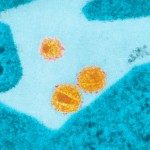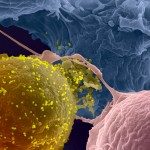Lien vers Pubmed [PMID] – 30521629
PLoS Pathog. 2018 Dec;14(12):e1007432
CCR5 plays immune functions and is the coreceptor for R5 HIV-1 strains. It exists in diverse conformations and oligomerization states. We interrogated the significance of the CCR5 structural diversity on HIV-1 infection. We show that envelope glycoproteins (gp120s) from different HIV-1 strains exhibit divergent binding levels to CCR5 on cell lines and primary cells, but not to CD4 or the CD4i monoclonal antibody E51. This owed to differential binding of the gp120s to different CCR5 populations, which exist in varying quantities at the cell surface and are differentially expressed between different cell types. Some, but not all, of these populations are antigenically distinct conformations of the coreceptor. The different binding levels of gp120s also correspond to differences in their capacity to bind CCR5 dimers/oligomers. Mutating the CCR5 dimerization interface changed conformation of the CCR5 homodimers and modulated differentially the binding of distinct gp120s. Env-pseudotyped viruses also use particular CCR5 conformations for entry, which may differ between different viruses and represent a subset of those binding gp120s. In particular, even if gp120s can bind both CCR5 monomers and oligomers, impairment of CCR5 oligomerization improved viral entry, suggesting that HIV-1 prefers monomers for entry. From a functional standpoint, we illustrate that the nature of the CCR5 molecules to which gp120/HIV-1 binds shapes sensitivity to inhibition by CCR5 ligands and cellular tropism. Differences exist in the CCR5 populations between T-cells and macrophages, and this is associated with differential capacity to bind gp120s and to support viral entry. In macrophages, CCR5 structural plasticity is critical for entry of blood-derived R5 isolates, which, in contrast to prototypical M-tropic strains from brain tissues, cannot benefit from enhanced affinity for CD4. Collectively, our results support a role for CCR5 heterogeneity in diversifying the phenotypic properties of HIV-1 isolates and provide new clues for development of CCR5-targeting drugs.



